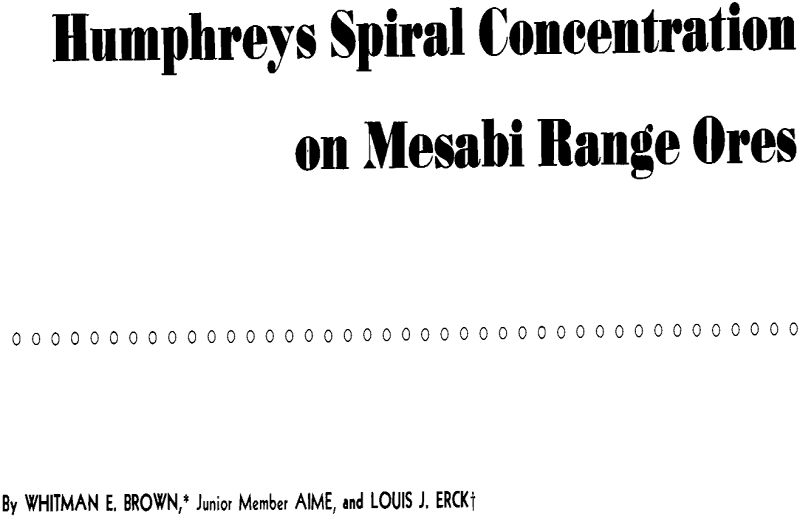Since it was introduced in 1943 to recover chromite from Oregon beach sands, the Humphreys spiral concentrator has proved successful in several fields of wet mineral beneficiation. By the end of 1957, 9390 Humphreys spirals had been manufactured. Most of these are still in service.

Requirements for Spiral Concentration: Valuable heavy minerals to be recovered must generally be —14 + 200 mesh, but outstanding examples will be discussed later where these size ranges are exceeded in commercial practice at both ends of the size scale.
Several medium size commercial applications have been made for mica, phosphate rock, and coal —special applications that are not limited strictly
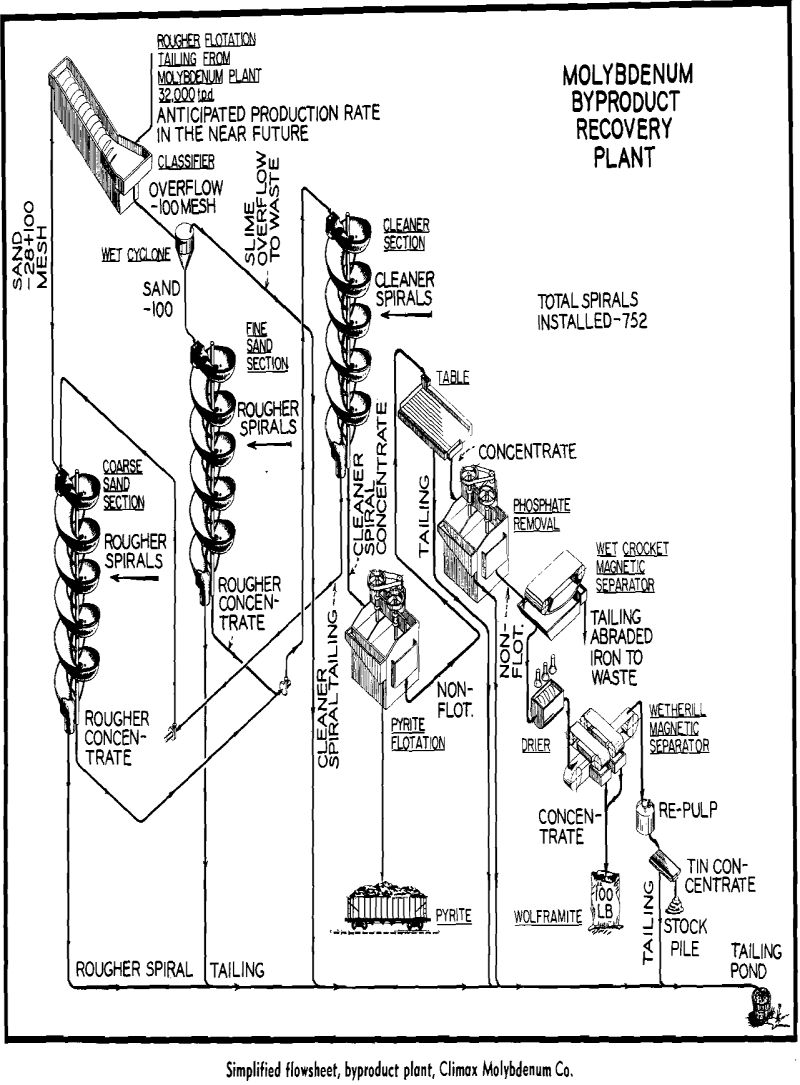
by these requirements for spiral concentration. The separation of mica and vermiculite from gangue minerals such as quartz, feldspar, and ferromagnesian minerals is dependent on the flaky shape of the micaceous minerals rather than on a significant difference in specific gravity.
Phosphate rock is another application where specific gravity differences are not involved in spiral separation. The phosphate rock pulp, generally —28 mesh, is reagentized at high pulp density with the usual reagents involved in phosphate rock flotation, such as fuel oil and tall oil. Stated simply, in the reagentized pulp the quartz gangue is wetted by water and the oiled phosphate rock is not. The wetted quartz gangue settles to the inside or lower part of the spiral channel where the velocity is low and is removed as a tailing via the normal heavy mineral draw-off port, which on most other ores delivers heavy mineral.
Fine coal below ¼ x 0 can be cleaned with Humphreys spirals. The model 24-C spiral used for coal cleaning has six turns of the helix in about the same headroom required for five turns in the model 24-A metallurgical spiral. In other words, the pitch is flatter. Only in the Pennsylvania anthracite region are there commercial plants for cleaning fine coal, but numerous pilot plant tests have demonstrated that many bituminous coals respond well to spiral treatment.
A very simple system has been devised by the Humphreys Investment Co. engineers to avoid such difficulty almost entirely and permit a multi-stage spiral plant to operate on coarse feed. The rougher spiral concentrate is composed of all sizes of heavy minerals present in the feed, but the gangue content is generally finer than 28 mesh. Consequently, treatment of the rougher concentrate in the simple elutriation or single-pocket sizer produces an underflow of very high grade heavy mineral that is finished coarse concentrate. The overflow, stripped of coarse heavy mineral, is ideally suited for the feed to the cleaner spiral section.

Field of Application: Processing Florida beach sands for the recovery of ilmenite, rutile, zircon, stauriolite, and monazite is the largest single type of application of Humphreys spiral concentrators. The ore is ideally suited to spiral concentration, since it completely satisfies the requirements for successful spiraling. The size range is substantially 100 pct —35 mesh + 200 mesh, the minerals are completely liberated, and there is significant difference of specific gravity between the gangue and heavy minerals.
Humphreys Gold Corp., mining affiliate of the Humphrey Investment Co., operates three plants in Florida under various contract agreements with E. I. du Pont de Nemours & Co. and the National Lead Co. There are 3374 spirals—35.9 pct of all spirals manufactured up to the end of 1957—employed in the three Florida beach sand plants.
The northern U. S. iron ore ranges account for the second largest group application of Humphreys spiral concentrators. On the iron ore ranges there are 1712 spirals, or 18.2 pct of all spirals manufactured to the end of 1957.
It would be worthwhile to discuss in detail some areas where the Humphreys spirals are definitely not suitable. With one exception, spirals have no application in recovery of sulfide minerals, where flotation has been shown to do a satisfactory and superior job.

Humphreys Spiral Concentration of Iron Ore
The installation in 1948 of a Humphreys spiral concentrator section at the Hill-Trumbull plant of The Cleveland-Cliffs Iron Co. is the latest commercial method on the Mesabi Range being used for the recovery of fine iron ore. In two stages of concentration 84 spirals treat approximately 120 long tons per hour of minus 1/8 in. ore. These spirals augment the production of the heavy-density plant which recovers the plus 1/8 in. iron from the plant crude ore. Structure of the ore is such that, when crushed, about 50 pct of the plant crude is minus 1/8 in. size. After desliming in a 66 in. Akins classifier, grinding the classifier product in a ball mill and again desliming in a 78 in. Akins classifier about 15 pct of the crude ore remains to be treated in the spiral plant.
Overall recovery of the ball mill feed in the Hill-Trumbull spiral plant during the 1948 season was about 53 pct of the weight and 66 pct of the total iron content. Of the actual feed delivered to the spirals from the 78 in. classifier 64.9 pct of the weight was recovered containing 73.7 pct of the total iron. The average analysis of the spiral concentrate is 55.05 pct Fe and 14.83 pct SiO2.

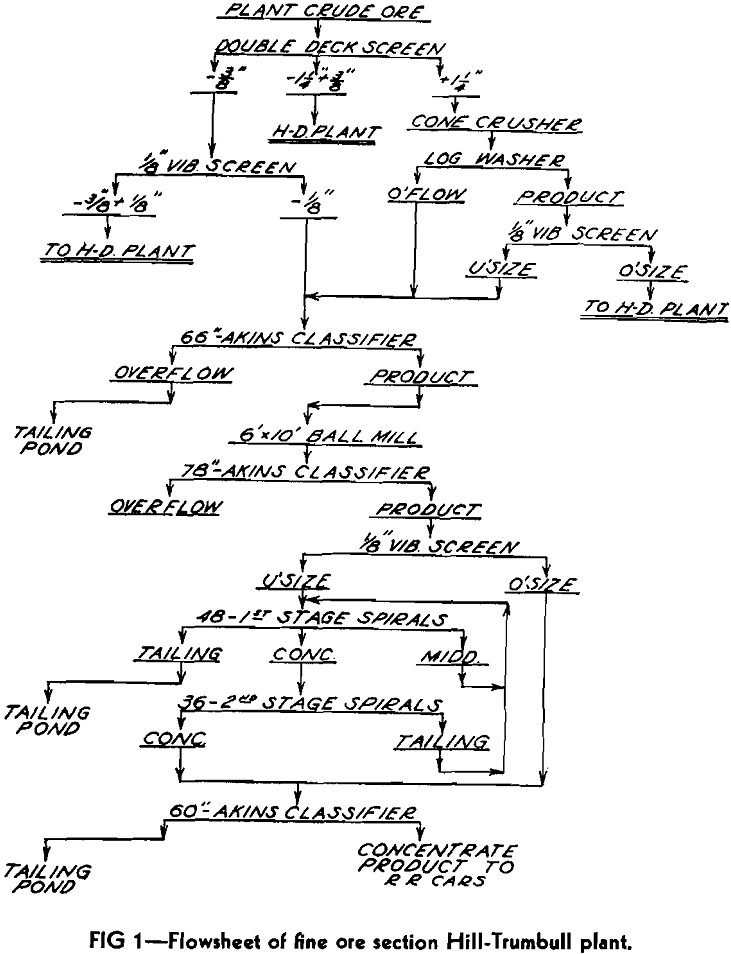
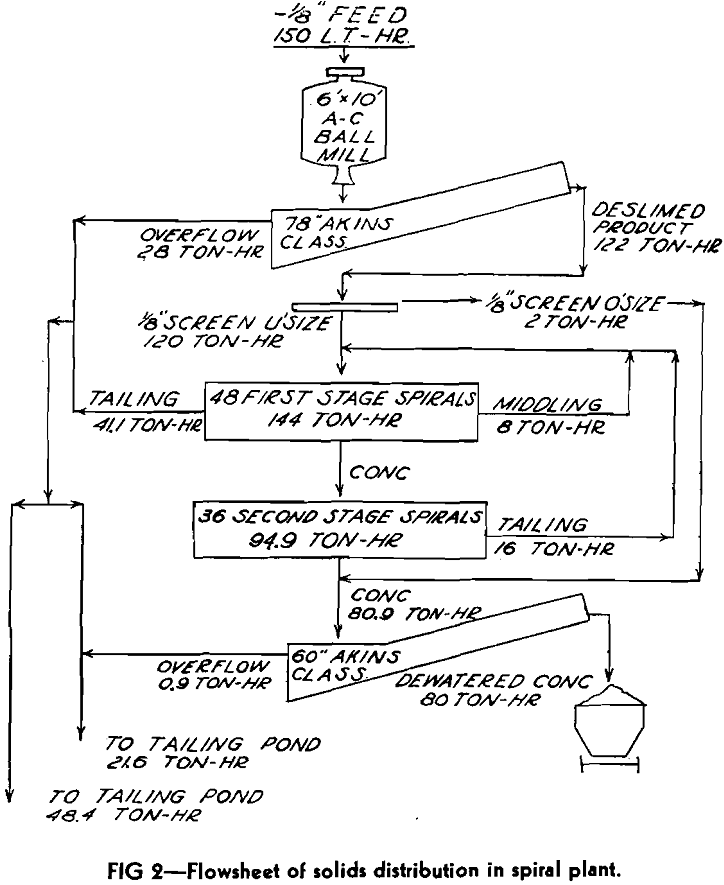
The Cleveland-Cliffs Iron Company Plant
Preparation of ore for the heavy-density plant is near standard practice. A slight divergence begins where the minus in. size material leaves the 66 in. Akins classifier as a product and is routed to a 6 by 10 ft Allis-Chalmers ball mill. The ball mill operates in open circuit, is charged with 2 in. diam balls, driven by a 200 hp motor and has a throughput of approximately 150 long tons of solids per hour. Pulp density in the mill is approximately 65 pct solids. The purpose of the ball mill is to subject the ore to a differential grind which liberates silica from the iron ore particles, and middling from the ore particles and from silica. It also assists in breaking down porous iron oxide particles. The ground product flows into a 78 in. Akins classifier which makes a size separation at nearly 200 mesh. The slime or overflow waste analyzes about 25 to 30 pct Fe and 50 to 60 pct SiO2. Classifier product containing about 75 pct solids drops onto a 4 by 8 ft
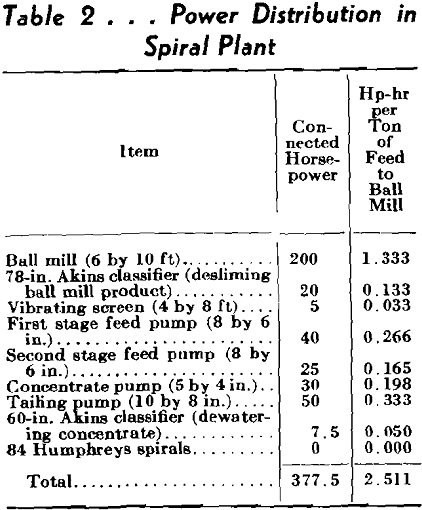
Spiral Plant Operation and Performance
All 84 spirals are policed by one operator who removes extraneous matter from the spirals, adjusts pulp density of spiral feed, and adjusts splitters and quantity of wash water. He also has time for additional duties including sampling and tending to the ball mill, pumps, classifiers, and screen.
If there is a power failure the spirals empty themselves by gravity.
Spiral operators are easily trained and after a reasonable length of time can become proficient. They are required to observe structure of the ore and to note changes which would suddenly increase or decrease the pulp density. When such changes occur, water is added or decreased to maintain the proper pulp density and launder make-up water. Occasionally, the Hill-Trumbull plant crude ore does not provide a sufficient amount of minus 1/8 in. material to adequately feed the spiral section. Before ringing for more feed the spiral operator consults the heavy-density plant foreman to determine how much more feed his section can stand. If the heavy-density plant is operating at maximum capacity and there is not enough ore coming to the spirals, this material is pumped to the 60 in.

Grinding
The 6 by 10 ft Allis-Chalmers ball mill was fed 150 long tons of solids per hour. Preliminary laboratory tests on this ore showed a distinct advantage in both grade and recovery if the fine ore were given a differential grind. Grinding is fast and in open circuit. Table 5 shows the size distribution before and after abrasion grinding giving analysis of samples from a single shift and illustrating results obtainable from abrasion grinding of this ore.
Spiral Concentration
Structure of the ore to be concentrated affects grade and recovery of spiral products. At the Hill-Trumbull plant two types of ore are treated in the spirals:
- Hard dense hematite with very little limonite and at times containing some taconite. Very fine grinding would be required for complete liberation of silica from the iron oxide. The concentrate is characterized by a high silica to iron ratio. The plus 14 mesh sizes of this type ore contain many flat pieces of iron oxide while the silica is rounded or blocky.
- Hard and soft hematite and limonite mixed with varying amounts of paint rock. Contained silica is liberated more easily from the iron oxide particles than in the other type ore. Spiral concentrate from this type ore usually contains less iron than the first type, but the silica content is lower. The reason for this is attributed to limonite in the concentrate.
In spiral concentration of an ore in which a large percentage of the weight and values is in the plus 35 mesh size, it is usually necessary to operate with a feed pulp density of about 40 pct solids and a pulp rate of 25 to 30 gpm.
